| For approximately 6,300 years, native peoples periodically camped at the Varga site on Hackberry Creek, hunting and gathering a variety of foods to eat and resources to use for their shelters and tools. In this exhibit, we have sought not only to trace their activities, but also to bring to the forefront the various technical analyses used to develop those interpretations. We have included a considerable amount of detail about the methods used in these studies in order to show that it is not a simple process to extract meaningful information from the bits and pieces recovered from archeological sites. Although eight types of studies are highlighted in this exhibit, several others, including optimically stimulated luminescence (OSL) dating of sediments and stable carbon and nitrogen isotope analyses, were conducted to maximize the opportunity for learning about the past. Taken as a whole, the results from this broad suite of analyses provide new insights into the past, some with regional consequence, others of lesser importance but of interest to researchers.
Four components, or major use periods, at the Varga site were identified and analyzed. We learned that throughout most periods, native campers at the site employed the same cooking technologies and made similar formal and informal chipped-stone tools. They relied predominantly on Edwards chert for their raw material. During the last 600-year period, the Toyah group(s) added two new technologies: the bow and arrow for hunting, which replaced the atlatl and dart system, and ceramic pottery, which was added to hot-rock techniques for cooking.
Projectile points, bifaces, end scrapers, and edge-modified flakes dominate the cultural artifacts recovered from each of the four major camping events represented. These stone tools are generally considered evidence of intensive hunting and meat processing activities. Ground stone tools typically associated with plant processing, such as manos and metates, were nearly absent from all assemblages. Based on the artifacts alone, including the bones from the Toyah interval, one would normally draw the conclusion that the occupants of these camps focused solely on animal resources.
It was only through various technical analyses, however, including the use of lipid residues and stable isotopes on the burned rocks, plus the microscopic residues observed on chipped-stone tools during use-wear analysis, that the use of plant resources at this site was documented. These findings are particularly valuable because plants typically are poorly preserved in open sites such as Varga.
Analysis of lipids, or fatty acids, on pottery sherds and burned rocks, while not specific in plant/animal identifications, nonetheless provided important clues to the foods consumed at the site, including the ways in which they were prepared. These findings underlined the dietary importance of plants to Varga campers. Nearly 80% of the burned rocks and ceramic samples analyzed were found to contain plant residues. Plants apparently were cooked both in ceramic containers as well as in pits or oven features that used hot rocks as cooking elements. Although there were numerous animal bones, including deer and bison, found at the site, the lipid analyses revealed surprisingly little direct evidence of cooking the meat. The lack of bison lipid residues on burned rocks from the Toyah component appears to indicate that meats were not cooked by these rocks. These varied findings suggest that meat was primarily eaten raw or dried (beef jerkey).
Use-wear analyses of stone tools from the Toyah component also emphasized the importance of plants during this time period. About 70% of the findings support use of tools on plants, while less than 15% indicate use on animals. Use-wear studies also revealed that the general shape of tools does not provide an adequate indication of tasks for which the tool was used, nor the material on which it was used. For example, use-wear on edge-modified flakes revealed many tasks that would have gone undetected, such as whittling and planing wood, scraping plant materials, and slicing meat. Further, the haft position on certain tools indicated different uses other than what more traditional forms of morphological tool classification might suggest. For example, several Cliffton points, a type of artifact widely believed to be Perdiz preforms, showed evidence of hafting. This indicates these Cliffton points were not preforms; rather, they had been hafted to a shaft and used.
Instrumental Neutron Activation Analysis (INAA) on stone tools, raw cherts, and ceramics provided a greater understanding of the procurement territory, or resource zones, of the Varga site occupants and the distance the raw materials were transported. It appears that, with few exceptions, most materials used to make the Varga tools and vessels were derived from nearby sources. This localized, or spatially constrained, operational area holds true in the Toyah component. This is rather interesting, given the widespread distribution of classic Toyah assemblages throughout much of the state.
Petrographic analyses provided specifics on pottery-making technology at the Varga site. These findings can now be compared to pottery from other sites. For example, the Varga ceramics contained an average of 36% ground bone particles used as temper, about 12% higher than other Toyah ceramics from the Rush and O. H. Ivie sites to the northeast, and the Onion Creek sites in south central Texas. On these sites, the bone temper average was about 24%. Although use of bone temper in Toyah ceramic technology is widespread across central Texas, variations in the amount may indicate choices of individual potters, differences in how the pots were used, and/or condition of the raw clay.
Comparisons between ceramics from prehistoric sites and Historic Period mission sites also show specific similarities and differences. The Varga study showed the changes which took place among native potters in mission settings. One was the adoption of new pastes and tempering sources; another was the reduction of the common use of bone temper (although note that some prehistoric pastes also lack bone). In the Historic period, we see the coexistence of several ceramic paste groups, followed by the gradual replacement of native, handmade pottery by that made on a mechanical wheel.
The diverse paleoenvironmental data obtained from multiple lines of evidence and interpretations indicate very minor changes to the past climate and vegetation communities during the 6300 years represented at this locale. A hint at a possible change to drier or warmer conditions is the appearance of bison and antelope in the Toyah subsistence base within the last 600 years. The appearance of these two species in the Toyah component potentially reflects the presence of more open grasslands during this period. However, human selection cannot be ruled out. This relatively minor change in the environment may have influenced human behavior and adaptation, resulting in repeated use of this locality and contributing to the relative consistency in the archeological record from the Varga site.
Additional information about the prehistoric environment was gleaned through stable carbon and nitrogen isotope analyses. In general, these two sets of values can be used to understand possible changes through time in past vegetation communities. Here, the nitrogen values changed very little. The carbon values showed increased negative values from oldest to recent. The latter increase of negative values over time reflects increase in flowering shrubs and trees. There was no real indication of zonation in the obtained values to reflect the visible soil stratigraphic boundaries. The negative carbon values also indicate there were few or no grasses that grow in warm/dry conditions. Therefore, this isotopic record shows no sign of the previously identified warm/dry Altithermal climatic period documented elsewhere. The Altithermal is generally thought to have existed between 6000 and 4500 years before present. The use of multiple technical analyses as done here, including pollen, phytolith, and isotope, strengthens and documents the finding that a significant warm and/or dry Altithermal period was not present at the Varga site.
An additional analysis also was performed to help date the site occupations. Six fine-grained alluvial sediment samples that contained few sand-grained size particles were relatively dated through optically stimulated luminescence (OSL). These samples were collected from the four cultural periods to date and compare with the more standard and numerous radiocarbon dates from these same four periods. The OSL dating technique has generally been applied to very sandy deposits. However, the OSL technicque here provided very positive results that are quite similar to the numerous radiocarbon ages obtained from the same cultural periods. Consequently, the seldom used OSL technique on the fine-grained alluvial sediments appears suitable for use even in these types of deposits. This provides yet another dating technique that can be used to determine the ages of the deposits surrounding the cultural artifacts in a alluvial setting.
Employing multiple techniques toward one general question/topic allows for a much stronger analysis of what really happened in the past. For example, the identification of charred plant parts (macrobotanical analysis) did not directly correspond with the pollen results. Here, if only one of these two techniques had been used, we would have ended with a single result that we believed represented the true nature of the past environment. With the use of two techniques (macrobotanical and pollen analyses), with somewhat conflicting results, we now must soften our interpretations as to what the past environment was really like.
Stable carbon and nitrogen isotope analyses also were conducted on the same burned rocks as the lipid residue analysis. The isotopic results definitely support the cooking of plants by the burned rocks through very negative carbon isotope values. This cooking strategy apparently did not change over the multiple events throughout time represented here. Again, the use of multiple technical analyses have provided new insights and understanding of the different food processing techniques.
Looking to the Future
The combined results from the various technical analyses at the Varga site have contributed detailed insights into human behavior and ecology at the site. It is hoped that these and other technical analyses will be conducted at other excavated sites. Continued use of diverse technical analyses will add considerable information to the growing database of findings, enabling greater understanding and more broad-based interpretation of prehistoric lifeways across Texas. It is also hoped that researchers will develop more standardized methodologies for the collection and analysis of samples, as well as report findings in such a way as to allow for incorporation into shared research databases, such as the Ceramics Database at the Texas Archeological Research Laboratory. By these means, the findings from individual sites from a specific time period can be analyzed as groups to extract greater meaning and understanding at a higher level of human behavior.
|
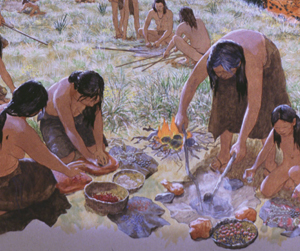
Indian women prepare food for a meal, using hot rocks for cooking. Inset from painting by Nola Davis, courtesy of Texas Parks and Wildlife Department.

|
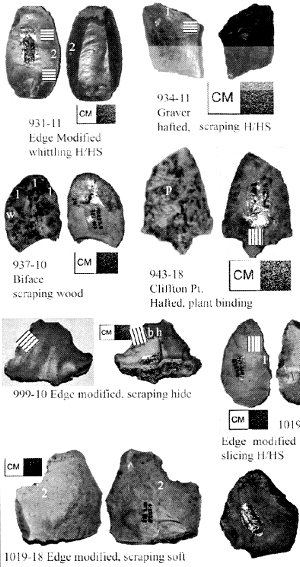
Examples of objects analyzed for microscopic traces of use-wear, with identifications of activities for which they were used. Of note is the Clifton point, shown in second row, which was found to have been hafted and used. This indicates this type was not a preform for an arrow point, as has been assumed by some archeologists for many years. Image from Quigg et al. 2008 (Figure C-6).

|
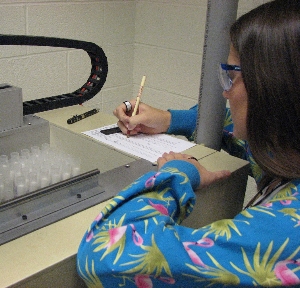
A technicians prepares samples taken from ceramic sherds and stone tools for instrumental neutron activation analysis, a process used in determing source of raw materials. This study was one of numerous technical analyses performed on Varga site materials. Image courtesy of MURR Laboratory.

|
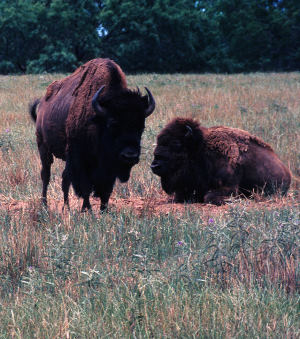
Bison was a major source of meat used by Varga campers, based on bone recovered from the site. Their presence, along with antelope, in the area during the Late Prehistoric period may indicate a shift to drier or warmer conditions. Photo by Mike Quigg.

|

Wood burning in a campfire. Analysis of charcoal from hearths and other features at the site helped researchers identify some of the fuel wood used by Varga campers. Photo by Mike Quigg.

|
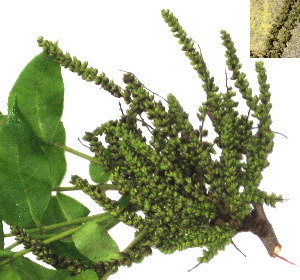
Pecan blossoms and their pollen. Analysis of both charred wood and pollen provided two lines of evidence for understanding what the prehistoric environment at the site was like. Photo by Susan Dial.

|
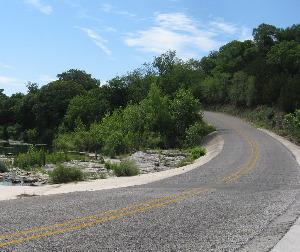
TxDOT’s reconstruction of the road and creek crossing, following their destruction by floodwaters, prompted the archeological study of the Varga site and uncovering of new insights about hunter-gatherer life on the Edwards Plateau.

|
|